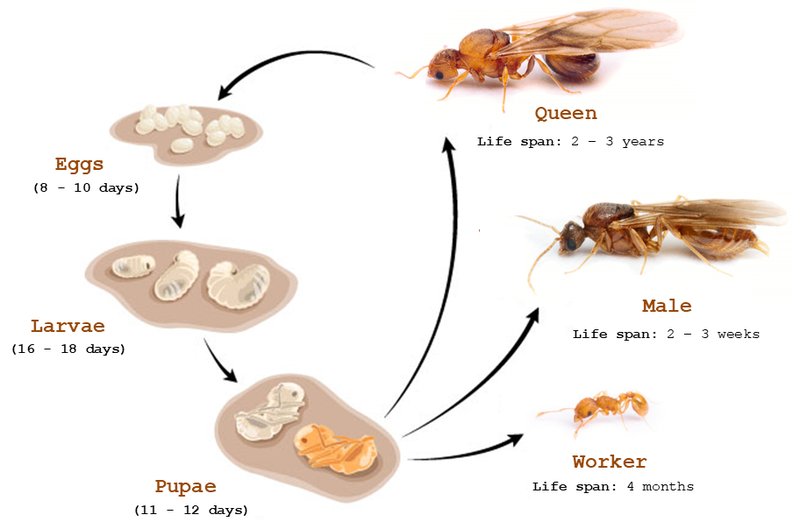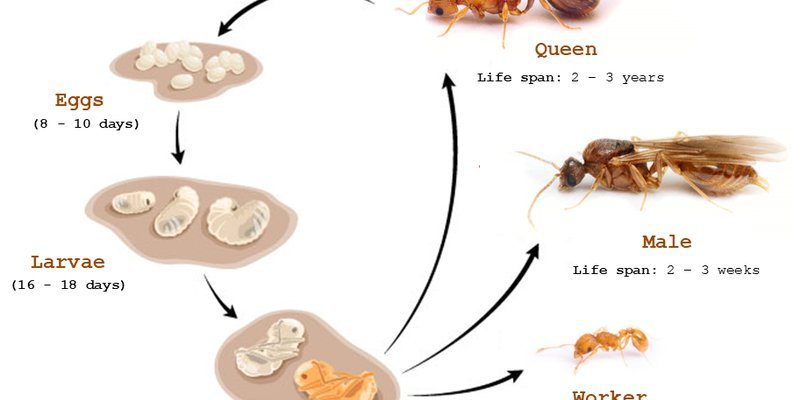
Just to clarify, we’re diving deep into the world of fire ants, specifically the red imported fire ant (Solenopsis invicta), one of the most notorious species. Understanding their lifecycle helps us appreciate these creatures beyond their reputation as pesky pests. So, grab your coffee, and let’s explore this intricate journey!
Stage 1: The Egg
Every fire ant starts its journey as a tiny egg. The queen lays these eggs in a warm, cozy nest, usually underground. Here’s the thing: these eggs are incredibly small—about the size of a pinhead. They’re creamy white, often hard to spot even when you’re looking directly at them.
Fire ant eggs go through several stages of development. After about 5 to 10 days, those eggs hatch into larvae, which look a bit like tiny, white worms. The queen can lay thousands of eggs in one go, so her job is crucial. Think of her as the heart of the colony, responsible for ensuring that there’s always a new generation ready to take on the world.
Stage 2: The Larva
Once the eggs hatch, the fire ant larvae enter a growth phase that lasts about 10 to 20 days. During this period, they need constant care. Worker ants, the female ants that aren’t queens, take on the role of caregivers. They feed the larvae, keep them clean, and even move them around to maintain optimal conditions.
An interesting fact is that these larvae go through several molts, shedding their skin as they grow. This process is sort of like a teenager deciding they need a wardrobe change. They need more space as they get bigger, and the workers are there to help every step of the way. It’s a bustling, nurturing environment, much like a busy daycare!
Stage 3: The Pupa
After the larval stage, fire ants enter the pupal stage. It’s kind of fascinating because they don’t just transform right before your eyes; they actually change inside a protective cocoon. This can last anywhere from a week to several weeks, depending on environmental conditions like temperature and food availability.
During this time, the workers keep the pupae safe and can move them around to ensure they stay in a nice, warm spot. Imagine being in a snug sleeping bag, knowing that your friends are watching over you while you morph into something new—pretty cozy, right?
Stage 4: The Adult Fire Ant
Finally, after about 30 days from egg to adult, the fire ant emerges from its pupal cocoon. Adult fire ants are typically about 1/8 to 1/4 inch long, with a distinct reddish-brown color. This is when they really get into their groove! They start off as workers or, if they’re a male or a queen, they’ll have different roles in the community.
What’s fascinating is that the roles of fire ants are pretty flexible. Worker ants can shift their duties based on the colony’s needs. They might forage for food, care for the queen, or protect the nest. It’s a bustling society, with each ant contributing to the success of their colony.
The Role of the Queen
No discussion of fire ant life would be complete without talking about the queen. She is the heart of the colony and can live for many years—up to seven or more! The queen is responsible for laying eggs and will do so continuously throughout her life. When you think about it, she’s kind of like a production machine, ensuring that her colony thrives and grows.
Interestingly, if the colony gets too big or if resources become scarce, the queen might start producing winged males and females. These ants will venture off to establish new colonies, allowing the fire ant population to expand. It’s like sending your kids off to college—exciting yet a bit bittersweet, right?
Colony Dynamics and Behavior
Fire ants are social creatures, and their colony structure is quite intricate. They exhibit a range of behaviors that help maintain their community. For instance, when they find food, they release pheromones, which are like chemical signals that tell other ants where to go.
Their aggressive nature often comes into play when defending their territory. If there’s a threat, you might see a cloud of fire ants swarm to protect their nest. It’s a testament to their teamwork. Each ant knows its role, and together, they form a protective barrier.
Challenges and Lifespan
The lifecycle of a fire ant isn’t all sunshine and flowers, though. They face several challenges, from environmental factors like temperature and moisture to predators like birds and other insects. However, a well-established colony can withstand many of these challenges, and the resilience of fire ants is impressive.
Typically, fire ants live around 30 days as workers, but queens can live much longer, as mentioned earlier. This longevity helps ensure that there’s always a next generation to step in when needed.
Why Understanding Their Lifecycle Matters
So, why should you care about the lifecycle of fire ants? Well, understanding how they grow and develop can help in managing them, especially if they become a nuisance. For example, knowing that they thrive in warm environments might give you insight into when and where they are likely to be most active.
Also, understanding their social structure can help with strategies for preventing infestations. It’s all about knowledge—knowing how they operate might just save you a few pesky bites in the future.
In conclusion, fire ants lead intricate lives from egg to adult. Each stage of their lifecycle has its own fascinating dynamics that contribute to the colony’s success. Whether you see them as a pest or simply part of the ecosystem, recognizing their unique development process helps us understand these tiny creatures a little better.
So next time you spot a fire ant, give it a moment’s thought. This little critter has quite the story to tell—one that’s a lot more interesting than just being a picnic crasher!

